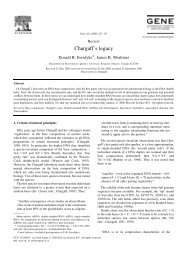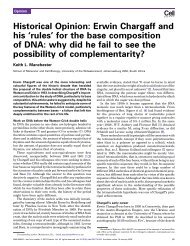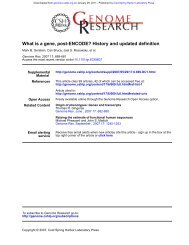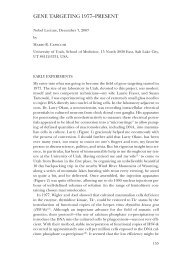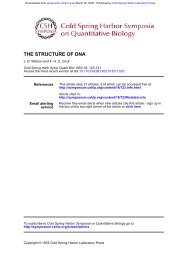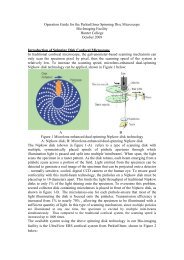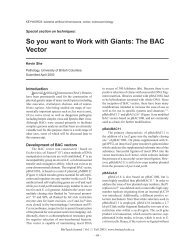Chemical specificity of nucleic acids and mechanism of ... - Biology
Chemical specificity of nucleic acids and mechanism of ... - Biology
Chemical specificity of nucleic acids and mechanism of ... - Biology
You also want an ePaper? Increase the reach of your titles
YUMPU automatically turns print PDFs into web optimized ePapers that Google loves.
208 E. CHA~AFF: <strong>Chemical</strong> Specificity <strong>of</strong> Nucleic Acids <strong>and</strong> Mechanism <strong>of</strong> their Enzymatic Degradation [EXPI~RIENTIA VoL. VI/6]<br />
yeast <strong>and</strong> avian tubercle bacilli ~ desoxyribose. It<br />
would seem that the free play with respect to the<br />
variability <strong>of</strong> components that nature permits itself<br />
is extremely restricted, where <strong>nucleic</strong> <strong>acids</strong> are concerned.<br />
X. Depolymerizing Enzymes<br />
Enzymes capable <strong>of</strong> bringing about the depolymerization<br />
<strong>of</strong> both types <strong>of</strong> <strong>nucleic</strong> <strong>acids</strong> have long<br />
been known; but it is only during the last decade that<br />
crystalline ribonuclease ~ <strong>and</strong> desoxyribonuclease~from<br />
pancreas have become available thanks to the work <strong>of</strong><br />
KUNITZ. Important work on the latter enzyme was<br />
also done by McCART¥ ~.<br />
Table IX ~<br />
Enzymatic degradation <strong>of</strong> calf thymus desoxyribo<strong>nucleic</strong> acid.<br />
Original .... 0 0<br />
Dialysate . . . 6 6<br />
Dialysis residue 24 72<br />
Composition <strong>of</strong> fractions<br />
~ ~ "~ (molar proportions)<br />
c ~'~<br />
~oi "- ~<br />
"~ ~ o ~ ~ "~l'~<br />
100 1.2<br />
53 1.2<br />
7 1-6<br />
1.3 1.6<br />
1-2 1.2<br />
2.2 3-8<br />
1.2<br />
1-0<br />
2.0<br />
We were, <strong>of</strong> course, interested in applying the<br />
chromatographic micromethods for the determination<br />
<strong>of</strong> <strong>nucleic</strong> acid constituents to studies <strong>of</strong> enzymatic<br />
reaction <strong>mechanism</strong>s for which they are particularly<br />
suited. The action <strong>of</strong> crystalline desoxyribonuclease on<br />
calf thymus desoxyribo<strong>nucleic</strong> acid resulted in the<br />
production <strong>of</strong> a large proportion <strong>of</strong> dialyzable fragments<br />
(53 per cent <strong>of</strong> the total after 6 hours digestion),<br />
without liberation <strong>of</strong> ammonia or inorganic phosphate.<br />
But even after extended digestion there remained a<br />
non-dialyzable core whose composition showed a<br />
significant divergence from both the original <strong>nucleic</strong><br />
acid <strong>and</strong> the bulk <strong>of</strong> the dialyzate 6. The preliminary<br />
findings summarized in Table IX indicate a considerabte<br />
increase in the molar proportions <strong>of</strong> adenine to<br />
guanine <strong>and</strong> especially to cytosine, <strong>of</strong> thyanine to<br />
cytosine, <strong>and</strong> <strong>of</strong> purines to pyrimidines. This shows<br />
that the dissymmetry in the distribution <strong>of</strong> constituents,<br />
found in the original <strong>nucleic</strong> acid (Table II), is<br />
intensified in the core. The most plausible explanations<br />
<strong>of</strong> this interesting phenomenon, the study <strong>of</strong> which is<br />
being continued, are that the preparations consisted<br />
<strong>of</strong> more than one desoxypentose <strong>nucleic</strong> acid or that<br />
the <strong>nucleic</strong> contained in its chain clusters <strong>of</strong> nucleotides<br />
1 E. VISCHER, S,ZAMENItOF, <strong>and</strong> E. CHARGAFF, J. Biol. Chem.<br />
177, 429 (1949).<br />
M. Ku~ITz, J. Gem Physiol. Z4, 15 (1940).<br />
3 M. KuNITz, Science 108, 19 (1948).<br />
4 M.McCARTY, J. Gem Physiol. 29, 123 (1946).<br />
From S. ZAM~NHOF <strong>and</strong> Ig.CltARGAFF, J. Biol. Chem. 178, 531<br />
(1949).<br />
e S.ZA~E~HOF <strong>and</strong> E.CnAnGAFF, J. Biol. Chem. 178, 531 (1949).<br />
(relatively richer in adenine <strong>and</strong> thymine) that were<br />
distinguished from the bulk <strong>of</strong> tile molecule by greater<br />
resistance to enzymatic disintegration.<br />
In this connection another study, carried out in<br />
collaboration with S. ZAMENHOF, should be mentioned<br />
briefly that dealt with the desoxypentose<br />
nuclease <strong>of</strong> yeast cells 1. This investigation afforded a<br />
possibility <strong>of</strong> exploring the <strong>mechanism</strong>s by which an<br />
enzyme concerned with the disintegration <strong>of</strong> desoxypentose<br />
<strong>nucleic</strong> acid is controlled in the cell. Our<br />
starting point again was the question <strong>of</strong> the <strong>specificity</strong><br />
<strong>of</strong> desox~entose <strong>nucleic</strong> <strong>acids</strong>; but the results were<br />
entirely unexpected. Since we had available a number<br />
<strong>of</strong> <strong>nucleic</strong> <strong>acids</strong> from different sources, we wanted to<br />
study a pair <strong>of</strong> desoxypentose <strong>nucleic</strong> <strong>acids</strong> as distant<br />
from each other as possible, namely that <strong>of</strong> the ox <strong>and</strong><br />
that <strong>of</strong> yeast, <strong>and</strong> to investigate the action on them <strong>of</strong><br />
the two desoxypentose nucleases from the same cellular<br />
sources. The desoxyribonuclease <strong>of</strong> ox pancreas has<br />
been thoroughly investigated, as was mentioned before.<br />
Nothing was known, however, regarding the existence<br />
<strong>of</strong> a yeast desoxypentose nuclease.<br />
It was found that fresh salt extracts <strong>of</strong> crushed cells<br />
contained such an enzyme in a largely inhibited state,<br />
due to the presence <strong>of</strong> a specific inhibitor protein. This<br />
inhibitor specificalIy inhibited the desoxypentose<br />
nuclease from yeast, but not that from other sources,<br />
such as pancreas. The yeast enzyme depolymerized the<br />
desoxyribose <strong>nucleic</strong> <strong>acids</strong> <strong>of</strong> yeast <strong>and</strong> <strong>of</strong> calf thymus,<br />
which differ chemically, as I have emphasized before,<br />
at about the same rate. In other words, the enzyme<br />
apparently exhibited inhibitor <strong>specificity</strong>, but not<br />
substrate <strong>specificity</strong>. It is very inviting to assume that<br />
such relations between specific inhibitor <strong>and</strong> enzyme,<br />
in some ways reminiscent ot immunological reactions,<br />
are <strong>of</strong> more general biological significance. In any<br />
event, a better underst<strong>and</strong>ing <strong>of</strong> such systems will<br />
permit an insight into the delicate <strong>mechanism</strong>s through<br />
which the cell manages the economy <strong>of</strong> its life, through<br />
which it maintains its own continuity <strong>and</strong> protects<br />
itself against agents striving to transform it.<br />
xI. Concluding Remarks<br />
Generalizations in science are both necessary <strong>and</strong><br />
hazardous; they car D, a semblance <strong>of</strong> finality which<br />
conceals their essentially provisional character; they<br />
drive forward, as they retard; they add, but they also<br />
take away. Keeping in mind all these reservations, we<br />
arrive at the following conclusions. The desoxypentose<br />
<strong>nucleic</strong> <strong>acids</strong> from animal <strong>and</strong> microbial cells contain<br />
varying proportions <strong>of</strong> the same four nitrogenous<br />
constituents, namely, adenine, guanine, cytosine,<br />
thymine. Their composition appears to be characteristic<br />
<strong>of</strong> the species, but not <strong>of</strong> the tissue, from which<br />
1 S. ZAMENHOF <strong>and</strong> B.CIIARGAFF, Science 108, 628 (1948); J. Bid.<br />
Chem. 180, 727 (1949).



